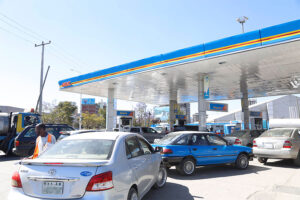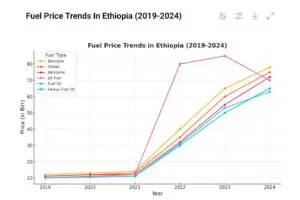From Addis to Rural Ethiopia: Bridging the Fuel Access Gap
Ethiopia, with its vast and varied landscapes, is a country of stark contrasts. While the capital city, Addis Ababa, thrives with modern infrastructure and a rapidly expanding economy, many rural regions remain underserved, especially when it comes to critical services like fuel. As the country continues its push towards economic development, one of the most pressing issues it faces is bridging the fuel access gap between urban and rural areas.
In this blog post, we will explore the regional disparities in fuel availability across Ethiopia, the challenges of infrastructure development, and the opportunities that lie in closing this gap for businesses, communities, and the nation as a whole.
1. Fuel Access in Addis Ababa: A Tale of Abundance
Addis Ababa, the political and economic heart of Ethiopia, is home to a significant concentration of gas stations, each equipped to meet the growing demand of a burgeoning urban population. With a thriving business environment, a steady influx of people, and an expanding middle class, the demand for fuel in Addis is high, but infrastructure development has been able to keep pace with the need. Modern fuel stations, digital payment options, and a variety of fuel offerings ensure that the city’s residents and businesses are well-served.
However, the fuel landscape in Addis Ababa paints only one part of the picture. The story changes dramatically as we move beyond the city’s urban sprawl to rural regions where access to fuel remains a significant challenge.
2. The Rural Fuel Struggle: Limited Access and High Costs
In Ethiopia’s rural areas, fuel access is a major bottleneck to economic development. For many, the nearest gas station could be dozens, if not hundreds, of kilometers away. Rural Ethiopians who depend on fuel for transportation, farming machinery, and even electricity generation often face the twin problems of fuel scarcity and high prices.
The lack of fuel infrastructure in these areas has far-reaching implications for the country’s economy. For example, farmers, who form the backbone of Ethiopia’s economy, are often unable to access affordable fuel for irrigation pumps or for transporting goods to market. Similarly, rural businesses and entrepreneurs struggle to grow due to the logistical challenges associated with fuel delivery.
In some cases, the fuel that is available in remote regions comes at a premium, due to the high transportation costs associated with getting fuel from major cities to far-flung towns. This makes fuel unaffordable for many rural households, impacting daily life and economic opportunities.
3. Government Efforts to Close the Gap: A Vision for Rural Fuel Distribution
Recognizing the importance of equitable fuel access, the Ethiopian government has begun to prioritize fuel infrastructure development, particularly in rural areas. Over the past few years, several initiatives have been launched to extend the fuel distribution network across the country.
One notable effort is the government’s investment in rural road construction and expansion. These roads not only facilitate the transportation of fuel but also help businesses and farmers access new markets, improving economic opportunities. Additionally, the Ethiopian Petroleum Supply Enterprise (EPSE) has been working on expanding its storage facilities and distribution networks to ensure that fuel reaches remote areas in a more reliable manner.
Furthermore, the government has also been exploring innovative models for fuel delivery, including the use of mobile fuel dispensers or small satellite stations that can be stationed in remote areas. This “decentralized” approach could significantly reduce fuel costs for rural communities, making it more accessible to a wider population.
4. Private Sector Involvement: The Role of Gas Stations in Rural Development
While the government plays a critical role in infrastructure development, there is also immense potential for private businesses to fill the gap in fuel access. Gas station owners and entrepreneurs who see the demand in rural Ethiopia have an opportunity to create a thriving market by investing in satellite fuel stations and mobile delivery systems.
Private companies can collaborate with local governments to establish strategically placed fuel stations along major transport routes connecting rural towns and urban centers. In doing so, these businesses not only tap into a growing market but also contribute to the country’s overall economic development by supporting sectors like agriculture, transport, and logistics.
Additionally, the growing demand for clean energy alternatives presents a new opportunity for gas station owners to invest in solar-powered stations or hybrid fuel solutions in rural areas. This shift would not only improve access to energy but also support Ethiopia’s broader goal of reducing reliance on imported fossil fuels and transitioning to renewable energy sources.
5. The Role of Technology: Smart Solutions for Fuel Delivery
As Ethiopia continues to develop its fuel infrastructure, technology will play an increasingly important role in bridging the fuel access gap. Mobile apps and digital payment platforms are already being utilized in urban areas to enhance fuel station services. However, these technologies can be equally valuable in rural settings, where they can streamline operations, improve delivery efficiency, and provide real-time information about fuel availability.
For example, mobile-based fuel delivery services could enable rural customers to request fuel directly from suppliers. Similarly, GPS tracking and smart inventory systems could help gas stations optimize their fuel distribution routes, ensuring that fuel reaches even the most remote communities in a timely and cost-effective manner.
These technological advancements, though still in their early stages, have the potential to revolutionize the way fuel is distributed in Ethiopia, particularly in rural areas.
6. The Way Forward: Investing in Rural Fuel Infrastructure
To truly bridge the fuel access gap between Addis Ababa and rural Ethiopia, a multi-faceted approach is needed. Collaboration between the government, private sector, and local communities is essential to ensure that fuel distribution infrastructure is expanded in a way that is sustainable, affordable, and efficient.
Here are a few ways to accelerate progress:
- Targeted Investments: Government and private sector investments should focus on creating decentralized fuel stations and mobile fuel delivery systems to reach rural areas.
- Policy Support: The government should continue to create policies that incentivize private sector investment in rural fuel infrastructure, such as tax breaks, subsidies, or low-interest loans for rural gas station development.
- Technology Integration: Embracing technology for better logistics, mobile payments, and efficient delivery systems will improve the fuel supply chain in rural areas.
- Sustainability: Encouraging renewable energy solutions, such as solar-powered fuel stations, will reduce dependency on traditional fuel sources and provide a greener future.
7. Conclusion: The Path to Fuel Equality
While Ethiopia has made impressive strides in modernizing its fuel infrastructure in urban areas, the work is far from finished. Bridging the fuel access gap between Addis Ababa and rural Ethiopia will require concerted efforts from all stakeholders, from government officials to private investors. With the right policies, infrastructure investment, and technological innovation, Ethiopia can ensure that all its citizens—regardless of where they live—have equal access to the fuel they need to drive economic growth and improve quality of life.
In the end, creating a more connected and fuel-secure Ethiopia will not only support the agricultural and transportation sectors but also empower communities and drive the nation towards a more sustainable and equitable future.
Do you operate a gas station? You can use Gas Pro, the first gas station management software in Ethiopia, to get these benefits:
Automated Tank Monitoring
Using Gas Pro, you can automatically measure your tank at the press of a button. This saves you time while increasing your measurement accuracy
Real-Time Fuel Level Alerts
Gas Pro will give “low fuel alerts” when the fuel reaches critical level and “fuel tank full” alerts when they fill up. This enables gas station owners and managers to coordinate supply of fuel.
Theft and Loss Prevention
Gas Pro’s dual-level sensors detect theft or tampering, reducing financial losses. Accurate records of fuel deliveries prevent disputes with suppliers.
Remote Pricing Control
Gas Pro enables you to remotely adjust the prices on your gas pumps thus increasing your ability to react to price changes made by the government.
More Stories

Operational Inefficiencies in the Ethiopian Gas Station Industry
Manual dipstick measurements and inventory tracking are labor-intensive, error-prone, and time-consuming. These methods often result in inventory discrepancies, which can lead to financial losses and operational disruptions.

Keeping the Pumps Running: Tackling Supply Chain Challenges in Ethiopia’s Fuel Market
Fuel is the lifeblood of any economy, powering everything from transportation and agriculture to industrial production. In Ethiopia, a nation undergoing rapid growth and development, the demand for fuel is rising steadily. Yet, ensuring a consistent and affordable fuel supply remains a formidable challenge.

From Addis to Rural Ethiopia: Bridging the Fuel Access Gap
Bridging the fuel access gap between Addis Ababa and rural Ethiopia will require concerted efforts from all stakeholders, from government officials to private investors. With the right policies, infrastructure investment, and technological innovation, Ethiopia can ensure that all its citizens—regardless of where they live—have equal access to the fuel they

The Future of Fuel: Opportunities and Growth in Ethiopia’s Gas Station Market
Ethiopia’s gas station market is at the cusp of transformation, and for those looking to invest, the future offers plenty of opportunities to drive growth and innovation. Whether you’re an entrepreneur looking to build your brand or an investor seeking profitable ventures, this is a sector worth watching.

Rising Prices, Rising Challenges: Navigating Fuel Costs in Ethiopian Gas Stations
Fuel prices are a central concern for gas station owners, operators, and consumers across Ethiopia. As a country that imports the majority of its petroleum products, Ethiopia is highly sensitive to global oil price fluctuations, foreign exchange availability, and government-imposed pricing regulations.

Fueling Ethiopia: How Government Policies Shape the Gas Station Industry
The gas station business in Ethiopia plays a pivotal role in keeping the country’s economy moving. From fueling vehicles to powering machinery, the availability and pricing of fuel impact everything from transportation costs to consumer goods.
